INDUS VALLEY CIVILIZATION CULTURE
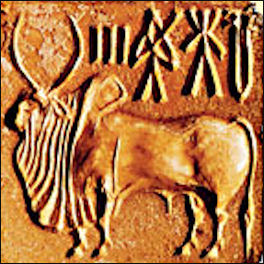
One of the first great civilizations — with a writing system, urban centers, and a diversified social and economic system—appeared around 3,000 B.C. along the Indus River valley in Punjab and Sindh. It covered more than 800,000 square kilometers, from the borders of Baluchistan to the deserts of Rajasthan, from the Himalayan foothills to the southern tip of Gujarat. The remnants of two major cities — Mohenjo-daro and Harappa — reveal remarkable engineering feats of uniform urban planning and carefully executed layout, water supply, and drainage. Excavations at these sites and later archaeological digs at about seventy other locations in India and Pakistan provide a composite picture of what is now generally known as Harappan culture (2500-1600 B.C.). [Source: Library of Congress *]
Archaeologists working at Indus sites have found evidence of writing on small stone stamp seals carved with images and a script that has yet to be deciphered. These seals may have been used to mark ownership of trade products. Mesopotamian and Iranian cylinder seals unearthed in the ruins testify to extensive trade with western Asian cultures. Houses, many two-storied, were provided with drains, washrooms, and latrines; civic and religious buildings, made of mudbrick, were located on walled citadels separated from residential areas. [Source: Steven M. Kossak and Edith W. Watts, The Art of South, and Southeast Asia, The Metropolitan Museum of Art, New York]
The major cities contained a few large buildings including a citadel, a large bath — perhaps for personal and communal ablution — differentiated living quarters, flat-roofed brick houses, and fortified administrative or religious centers enclosing meeting halls and granaries. Essentially a city culture, Harappan life was supported by extensive agricultural production and by commerce, which included trade with Sumer in southern Mesopotamia (modern Iraq). The people made tools and weapons from copper and bronze but not iron. Cotton was woven and dyed for clothing; wheat, rice, and a variety of vegetables and fruits were cultivated; and a number of animals, including the humped bull, were domesticated. Harappan culture was conservative and remained relatively unchanged for centuries; whenever cities were rebuilt after periodic flooding, the new level of construction closely followed the previous pattern. Although stability, regularity, and conservatism seem to have been the hallmarks of this people, it is unclear who wielded authority, whether an aristocratic, priestly, or commercial minority. *
Book: “Encyclopedia of Ancient Asian Cultures” By Charles Higham
Indus Valley: an Urban Civilization
Indus Valley civilization was essentially a city culture sustained by surplus agricultural produce and extensive commerce, which included trade with Sumer in southern Mesopotamia in what is today modern Iraq. Copper and bronze were in use, but not iron. Mohenjo-daro and Harappa were cities built on similar plans of well-laid-out streets, elaborate drainage systems, public baths, differentiated residential areas, flat-roofed brick houses and fortified administrative and religious centers enclosing meeting halls and granaries. Weights and measures were standardized. Distinctive engraved stamp seals were used, perhaps to identify property. Cotton was spun, woven, and dyed for clothing. Wheat, rice, and other food crops were cultivated, and a variety of animals were domesticated. Wheel-made pottery — some of it adorned with animal and geometric motifs — has been found in profusion at all the major Indus sites. A centralized administration has been inferred from the cultural uniformity revealed, but it remains uncertain whether authority lay with a priestly or a commercial oligarchy. [Source: Peter Blood, Library of Congress, 1994 *]
By far the most exquisite but most obscure artifacts unearthed to date are the small, square steatite seals engraved with human or animal motifs. Large numbers of the seals have been found at Mohenjo-daro, many bearing pictographic inscriptions generally thought to be a kind of script. Despite the efforts of philologists from all parts of the world, however, and despite the use of computers, the script remains undeciphered, and it is unknown if it is proto-Dravidian or proto-Sanskrit. Nevertheless, extensive research on the Indus Valley sites, which has led to speculations on both the archaeological and the linguistic contributions of the pre — Aryan population to Hinduism's subsequent development, has offered new insights into the cultural heritage of the Dravidian population still dominant in southern India. Artifacts with motifs relating to asceticism and fertility rites suggest that these concepts entered Hinduism from the earlier civilization. Although historians agree that the civilization ceased abruptly, at least in Mohenjo-daro and Harappa there is disagreement on the possible causes for its end. Invaders from central and western Asia are considered by some historians to have been "destroyers" of Indus Valley civilization, but this view is open to reinterpretation. More plausible explanations are recurrent floods caused by tectonic earth movement, soil salinity, and desertification.
Indus Valley Steatite Seals
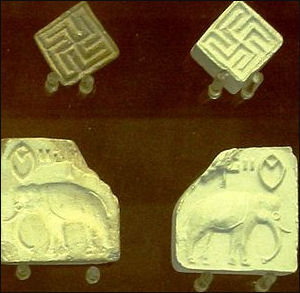
elephants and swastikas By far the most exquisite but most obscure Harappan artifacts unearthed to date are steatite seals found in abundance at Mohenjo-daro. These small, flat, and mostly square objects with human or animal motifs provide the most accurate picture there is of Harappan life. They also have inscriptions generally thought to be in the Harappan script, which has eluded scholarly attempts at deciphering it. Debate abounds as to whether the script represents numbers or an alphabet, and, if an alphabet, whether it is proto-Dravidian or proto-Sanskrit (see Languages of India). [Source: Library of Congress]
Steven M. Kossak and Edith W. Watts from The Metropolitan Museum of Art wrote: “Thousands of steatite seals like these have been discovered in the ruins of ancient sites throughout Pakistan and North India. Carved with a copper or bronze burin, the images on the seals depict powerful animals such as elephants, lions, rhinosceri, and bulls. Each seal bears letters in a writing system that is still undecipherable. One famous seal shows a figure seated in a yogic pose of meditation surrounded by animals, perhaps a prototype of the Hindu god Shiva as “lord of the animals.” On these seals, the powerful creatures face ritual stands. Above them are letters or characters, which may represent the name of a family or merchant organization involved in the network of trade extending across western Asia. Indus Valley stamp seals found in ancient Mesopotamian cities and Mesopotamian seals found at Indus Valley sites prove the exis- tence of long-distance trade. Stamp seals were used in the following way: clay was pressed over cords binding bundles of merchandise and then the seal was stamped into the clay. Any attempt to tamper with the contents would be immediately evident. [Source: Steven M. Kossak and Edith W. Watts, The Art of South, and Southeast Asia, The Metropolitan Museum of Art, New York]
Book: “Encyclopedia of Ancient Asian Cultures” By Charles Higham
Indus Language and the World's Oldest Writing?
Some scholars believe the Indus people spoke a language that belongs the Dravidian family, which includes Tamil and about 25 other languages, many of them spoken in southern India.
The language of Mohenjo-Daro is among the written languages that have not been deciphered. Other include the Minoan language of Crete; the pre-Roman writing from the Iberian tribes of Spain; Sinaitic, believed to be a precursor of Hebrew; the Futhark runes from Scandinavia; Elamite from Mesopotamia; the earliest Egyptian hieroglyphics; and Archaic Sumerian, the earliest written language in the world.
A 5,500 year-year-old inscription found on pottery in Pakistan in 1999 may be the world's oldest writing. A piece of pottery found at Harappa, dating between 3300 and 3000 B.C., contains branch-like lines that are similar to a trident-shaped symbol that appeared centuries later.
The Indus people had a written language. Thousands of examples have been unearthed. Despite the best efforts by scholars, it is still undeciphered. This is one of the main reasons why so much about the Indus culture remains a mystery.
Writing found on stone seals may have served as a form of personal identification. Seals sometimes had writing accompanied by figures of people, animals or mythical beats. Writing has also been found on button seals and inscribed shards.
Indus Seals and Deciphering the Indus Written Language
Scholars have counted more than 400 different symbols inscribed on seals, pottery shards and other surfaces. The inscriptions are short. The longest has 26 symbols. The average is around five. Scholars believe they symbols represent words, syllables or sounds and, based on analysis of overlapping strokes, was read from right to left. Some of the earliest writing was done on perishable palm leaves. Much of this has been lost to time.
The Indus languages disappeared when the Indus Valley civilization collapsed. Nothing like a Rosseta stone has been found. Summing up efforts to decipher the language, the University of Pennsylvania’s Gregory Possehl told National Geographic, "Everybody is guessing...99.9 percent is probably useless speculation."
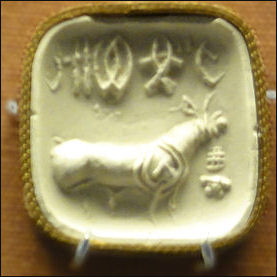
Indus stamp seal Postage-stamp-size seals found at Harappa have yielded a wealth of information about the Indus culture. Made mostly of a soft stone known as steatite, the seals bear inscribed writing and images of Zebu bulls, unicorns, three-headed buffalo, elephants, rhinos, crocodiles and other beasts. Sometimes the writing was accompanied by figures of people, animals, or mythical beasts. Images of unicorns on tokens and seals are so common that some scholars think the unicorn was the symbol of a ruling community.
The inscribed writing on seals may have served as "forms of personal identification, guarded as carefully as today's credit cards." The seals were often used to stamp rectangular impressions on clay rectangles probably attached to trade goods to show ownership. Scientists think the animals and beasts were probably the emblems of powerful clans. The inscriptions have not been deciphered.
Mesopotamian seals are exquisitely carved cylinders of stone or metal that look like miniature rotating drums. When rolled over soft clay they leave a reverse image or a message, often in extraordinary detail. They were often used as signature much like chops used by Chinese and Japanese today and waxed seals used in medieval Europe. If ink is applied to the seals and they are rolled on a piece of paper they will print the objects or symbols on the seal. In Mesopotamia there were large seals and seal rings. Most seals were about an inch high and came in widths defined by the images on them. They were used to mark documents of property and were worn as bracelets or necklaces and were often buried with their owners when they died.
Confusion Over what Language the Indus Written Language Represents
Iravatham Mahadevan, an expert in epigraphy from southern India believes the Indus script may have been a forerunner of so-called Dravidian languages, such as Tamil, spoken today in southern India and Sri Lanka. In addition to technical clues, he says the continued existence of a Dravidian language in modern Pakistan – Brahvi, which is spoken by people in parts of Balochistan – supports his idea. [Source:Andrew Buncombe, The Independent, March 25, 2010]
Andrew Buncombe wrote in The Independent,“Over the years, there have been plenty of other theories both from established experts and enthusiastic amateurs. Some, with the backing of Hindu nationalists, have claimed the script may be an early Indo-European language and that remnants of it may even exist in Sanskrit, an ancient language that is the root of many present languages in north India, including Hindi. It has even been claimed the Indus script belonged to metalsmiths, and others believe it died out with the city of Harappa itself and gave rise to no successor.
▪ “Part of the problem for the experts is that, unlike for those who cracked the hieroglyphics of Egypt, there is no equivalent of the Rosetta stone, the slab of granite-like rock discovered in 1799 that contained Egyptian and Greek text. In the 1950s, academic interest in Mayan hieroglyphics intensified when experts began to study modern spoken Mayan, but for the Indus scholars there is no agreement on which, if any, modern language is the successor to their script.
Is the Indus Written Language Really a Language?
Indus valley lies ar at the centre of one of the most acrimonious disputes in academia, a controversy that has allegedly led to death threats and claims of racism and cultural chauvinism. Andrew Buncombe wrote in The Independent: “Many experts in south Asia and elsewhere believe that symbols and marks inscribed on seals and other artefacts found here represent an as yet undeciphered language. Arguing it may be the predecessor of one of several contemporary south Asian argots, these experts say it is proof of a literate Indian society that existed more than 4,000 years ago.nBut other experts based in the West say although the symbols may contain information, they are not a true language. They claim the judgement of their counterparts in south Asia may be swayed by regional nationalism.
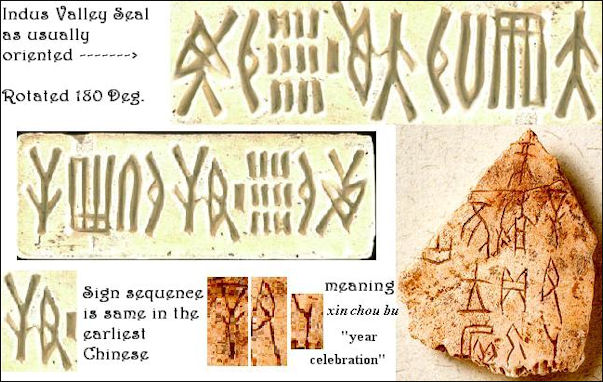
Indus Chinese Comparison
“Mohammed Hassan is curator of the museum in Harappa beside the dust-blown ruins.” He “insisted the people of Harappa must have possessed a written language to store information. "If they were not literate, then how could they do so many things?" he said. "They had well-made pottery, big cities that were well-planned. They had a lot of knowledge about these things. They grew cotton, wheat, rice and barley. They traded with other cities." Like Mr Hassan, Iravatham Mahadevan, an expert in epigraphy from southern India who has been awarded the country's highest civilian award for his work, has no doubts the symbols on the Indus seals represent a genuine language. "Archaeological evidence makes it inconceivable that such a large, well-administered, and sophisticated trading society could have functioned without effective long-distance communication, which could have been provided only by writing," he wrote last year in a magazine. "And there is absolutely no reason to presume otherwise,considering that thousands of objects, including seals, copper tablets, and pottery bear inscriptions in the same script throughout the Indus region. The script may not have been deciphered but that is no valid reason to deny its very existence."
“In 2004, the debate was jolted into a war of words after three American scholars claimed the Indus symbols were not a language at all. In a paper provocatively subtitled The Myth of a Literate Harappan Civilisation, they said there was insufficient evidence that the symbols constituted a proper language. They pointed to various factors: that there was no single long piece of text; that there was disagreement over the number of actual symbols and that other well-organised societies had been illiterate. The symbols, they argued, may well contain information in the same way that an image of a knife and fork together might represent a roadside eatery but they were not a language that could record speech.
“The ensuing uproar came mainly from south Asians. One of the American scholars, Steve Farmer claimed people would approach him in tears after he gave talks and that he had even had death threats. Comments on internet discussion boards accuse him and his colleagues of trying to prove that "non-Western cultures were less advanced". Mr Farmer, who lives in California, said he believed much of the anger was driven by those wishing to promote pet theories about Dravidians, indigenous Aryan Hindus or "the general man in the street who wants to think ancient India was of the same order as Egypt or Mesopotamia. It's total rubbish". He added: "I have never seen anything like the passion that there is in India. There is not that sort of passion in the Middle East about ancient things."
“More recently, the Indus controversy has been joined by a team of Indian scientists who ran computer programmes which led them to conclude the symbols almost certainly constitute a language. Central to their claims, published last year in Science, was the theory of "conditional entropy", or the measure of randomness in any sequence. Because of linguistic rules – such as in English the letter Q is almost always followed by a U – in natural languages the degree of randomness is less than in artificial languages.
“One of the authors, Rajesh Rao, who was born in Hyderabad but is now based at the University of Washington, became fascinated by the Indus culture after studying it at school. His team measured the randomness with which the individual Indus symbols appeared on seals and compared that to the randomness of several natural and artificial languages. Mr Rao said it was closest to a natural language. "The Indus civilisation was larger than the ancient Egyptian, Chinese, and Mesopotamian civilisations and the most advanced in terms of urban planning and trade," he said. "Yet we know little about their leaders, their beliefs, their way of life, and the way their society was organised. Many of us hope that decoding the script will provide a new voice to the Indus people."
“Yet as soon as Mr Rao's team published its findings, Mr Farmer and his colleagues hit back, denouncing their conclusions and methodology. Mr Rao, whose team has since issued a detailed defence of their theory, said he was surprised at the level of contention, within south Asia and beyond, but also at some of the comments he claims Mr Farmer's group levelled at him.”
Indus Valley Religion
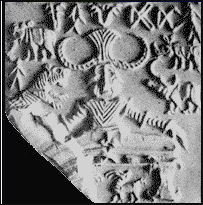
We know as little about the Indus religion and philosophy as we do about their language. The Indus people left behind no large monuments to their religions. Most of what is known is derived from small miniatures described as "small, modest, even humble expressions of human sentiment."
Steven M. Kossak and Edith W. Watts from The Metropolitan Museum of Art wrote: “An ancient form of religious practice was the worship of spirits believed to dwell in trees, rivers, and rocks. Many Indians still hold such beliefs. One form these beliefs took is the worship of yakshas and yakshis, male and female deities associated with the fertility of the earth. Serpent kings called nagarajas and their consorts, naginis, as well as makaras, fabulous crocodilelike creatures, are all associated with the cult of life-giving waters. These early deities were incorporated into the major Indian religions as minor gods. [Source: Steven M. Kossak and Edith W. Watts, The Art of South, and Southeast Asia, The Metropolitan Museum of Art, New York]
“Only fragmentary information can be pieced together about the religion of the Indus Valley civilization. Horned animals, trees, many female figurines (probably mother goddesses), and phallic sculptures suggest that the people practiced some kind of fertility worship. Depictions of figures in yogic postures suggest that meditation was used. These images relate to those of later Indian religions, and some may be prototypes of later Indian deities.
The figures of deities on seals indicate that the Harappans worshipped gods and goddesses in male and female forms and has also evolved some rituals and ceremonies. No monumental sculpture survives, but a large number of human figurines have been discovered, including a steatite bust of a man thought to be a priest, and a striking bronze dancing girl. Countless terra-cotta statues of Mother Goddess have been discovered suggesting that she was worshipped in nearly every home. [Source: Indian government Ministry of External Affairs]
Professor Gavin Flood wrote: “Religion in the Indus valley seems to have involved temple rituals and ritual bathing in the 'great bath' found at Mohenjo-Daro. There is some evidence of animal sacrifice at Kalibangan. A number of terracotta figurines have been found, perhaps goddess images, and a seal depicting a seated figure surrounded by animals that some scholars thought to be a prototype of the god Shiva. Others have disputed this, pointing out that it bears a close resemblance to Elamite seals depicting seated bulls. One image, carved on soapstone (steatite), depicts a figure battling with lions which is reminiscent of the Mesopotamian Gilgamesh myth. |::| There may be continuities between the Indus Valley civilisation and later Hinduism as suggested by the apparent emphasis on ritual bathing, sacrifice, and goddess worship. But ritual purity, sacrifice and an emphasis on fertility are common to other ancient religions.” [Source: Professor Gavin Flood, BBC, August 24, 2009]
“Some time after the collapse of the Indus Valley civilization, Aryans migrated down to the subcontinent from Central Asian steppes, bringing with them beliefs in gods, predominantly male, who personified forces and nature and were worshipped in elaborate sacrifices performed by Brahmins, the priestly class. The Aryans composed religious texts beginning with the Rig Veda, Soma Veda, and Athar Veda (ca. 1500–1200 B.C.), which contained hymns to the gods and descriptions of the customs, behavior, and traditions of Aryan life. The Upanishads, composed later (700–500 B.C.), contain profound philosophical speculations about the “One who lies behind.” This “One,” called Brahman, is eternal, formless, all encompassing, and the origin and essence of all things.”
Indus Phallic Symbols and Animal Cults
Religious life may have revolved around fertility cults. Miniatures of decorated, pregnant females with high collars and headdresses, collected from Mohenjo-Daro seem to suggest the Indus Valley civilization worshipped mother-goddess figures. Terra cotta figures, often heavily adorned with jewelry and wearing elaborate headdresses, have been excavated from a number of sites. As a balance some scholars also believe the Indus people paid homage to phallic gods as well. The miniatures may have been offerings brought by people who hoped their wishes would be granted.
A figure with a human face, the trunk of elephant, the hind quarters of a tiger and the hind legs of bull has been found on seals. Humans with the horns of bulls or water buffalos have been found on tokens. These discoveries have led some scholars to conclude the Indus people were members of animal cults.
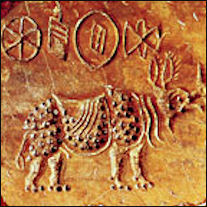
Among the other animals depicted on tokens and seals are rhinos, crocodiles and elephants. Images of unicorns are particularly common. The unicorn symbol disappeared from the subcontinent after the Indus Valley civilization collapsed. Another token shows a human head set before a horned figure like an offering.
Scores of stone phallic, vulva and bull figures have been found that are similar to iconic symbols in Hinduism. Some archaeologists and historians present this as evidence that Indus religion may have been the precursor to Hinduism. The bull was mount of the Hindu god Shiva. Indus phallic symbols' resembled the “lingam”. (phallic emblems) used in the worship of Shiva. Some tokens show humans bowing before a pipal tree shading figures that may be deities. Pipal trees symbolize fertility and protection in Hinduism.
One three-sided seal that was unearthed depicts a squatting god surrounded by animals which, some scholars say, may have been a forerunner of Shiva. Some of the most beautifully carved images on seals are of cattle, which suggests a link to cattle worship.
Indus Burials and Funerals
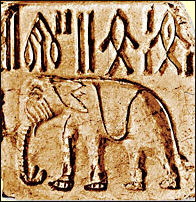
No sumptuous graves — like those in ancient Egypt — have been found in the Indus area. Very few cemeteries of any kind have been found, which has led scholars to conclude that most dead people were cremated and burial may haven reserved for a few important people. Graves around Harappa and Mohenjo-Daro always point north. Dholavira graves point east or northeast and contain pottery but no bodies. Maybe there were only memorials and bodies were cremated or buried elsewhere. Amulets and personal items have been unearthed in a few burials.
DNA studies of human remains show that women were often buried near their mothers or grandmothers. Thus far no similar pattern has been discovered with men. Unlike burials in Egypt and Central Asia, no great treasures or caches of art buried have been found in Indus graves.
An examination of the data available, both at Mohenjo-daro and Harappa, shows that probably there were then three methods of disposing of the dead : (a) complete burial, (b) burial after exposure of the body to birds and beasts, (c) cremation followed by burial of the ashes. The discovery of cinerary urns and jars, goblets or vessels with ashes, bone, and charcoal may, however, suggest that during the flourishing period of the Indus valley culture the third method was generally in vogue. At Mohenjo-daro, about a score of skeletons, some in public streets and others in a room, have been unearthed, but there is no trace of a cemetery or burial place. At Harappa, on the other hand, a cemetery has been brought to light in the plain level ground neat the mounds. It is noteworthy that the remains of the dead at the latter site are associated with a distinct type of pottery decorated with vegetable patterns and peculiar animal designs. [Source: “History of Ancient India” by Rama Shankar Tripathi, Professor of Ancient Indian History and Culture, Benares Hindu University, 1942]
Indus Society
The lack of grand monuments and ornate tombs has led some scholars to conclude the Indus culture was "an elaborate middle-calls society" made up of traders, landlords and religious leaders who shared power in a benign way. Unlike the ancient Egyptians and Mesopotamians, who lived in stratified society with the rich in large palaces and poor in mud huts, Indus valley society seemed to be egalitarian, with the lower classes living in pretty good housing.
Even so the huge variation of size in dwelling not only suggested the presence of an elite it also suggested levels of stratification. Some have even suggested that the origin of the caste system lies in this stratification. Some settlements have a raised area surrounded by walls. There is some evidence these areas were inhabited by the elite and the walls were there perhaps to separate them from the lowere echelons of society.
There is no so sign of great rulers. Even so, some scholars believe Dholavivia required a strong ruler to coerce workers to do all the work that was done there. Tablets depict images of grand processions that were perhaps expressions of wealth and status by merchants, landowners and spiritual leaders. Some sculptures depict bearded men with their hair tied back in a bun. Were these high status priests or rulers?
Indus Homes and Construction
Indus, Buildings, Homes and Construction
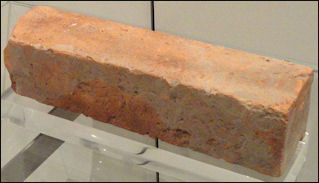
Cut brick from Harappa The buildings at Harappa and Mohenjo-Daro vary considerably in size and appear to have been plain but dignified. Stone not being easily obtainable, walls were raised of burnt brick, laid in mud or in both mud and gypsum mortar. Crude or sun-dried bricks were reserved for foundations and terraces, where the elements could not do much damage. There were stairways leading to upper storeys, and windows and doors for admitting light and air. Bath-rooms and circular brick-wells were important features of most houses. The system of drainage, public or private, was remarkable. Dust-bins and rubbish chutes are present. Even ordinary dwelling houses were provided with necessary conveniences. The larger structures were perhaps public property. One of them, a spacious pillared hall of the Intermediate Period, may have been a shrine, although no images have been found there.The most striking of all remains is, no doubt, a vast hydropathic establishment — a brick bath. [Source: “History of Ancient India” by Rama Shankar Tripathi, Professor of Ancient Indian History and Culture, Benares Hindu University, 1942]
Homes were periodically elevated, some scholars speculate, to avoid the runoff from a neighbors sewers. Mark Kenoyer of the University of Wisconsin told Discover, "It's keeping up with the Joneses that made these cities rise so quickly."
The Indus people were the first people to use fire-hardened bricks. In Mohenjo-Daro brick construction similar to modern brick construction was used. The bricks used for building fortifications followed a strict geometric 4-x-2-x-1 ratio, with the most a standardized 28-x-14-x-7 centimeters. Harappa kilns produced millions of bricks. They were so well made that British railroad workers scavenged them in the 1850s for ballast for their new tracks. One reason the brick industry was so developed was that building stone and wood were scarce.
Privacy seems to have been important. Houses generally opened on to quite lanes rather than the busy streets, Windows were rare and many houses had their own wells. Some houses had courtyard or alcoves.
Indus Cities and Planning
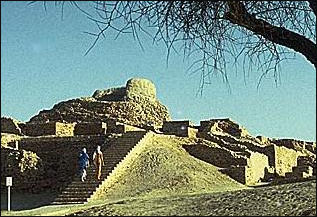
Indus cities were laid out in grids and contained granaries, fired-brick buildings, extensive baths, gardens. and brick buildings made with uniform-size bricks. The archeologist Mortimer Wheeler wrote in the 1950s, "however impressive quantitatively, and significant sociologically...aesthetically they are miles of monotony” .
There were wide streets and lanes at regular intervals. Individual homes supplied with water from wells and waste water diverted to covered drains. There were municipal buildings, marketplaces, dockyards, granaries, warehouses and protective walls to shield inhabitants from floods.
The Indus culture is credited with building some of the world's first planned cities. The major cities had the same basic plan: streets were laid out in a north-south, east-west grid with buildings made from standard-size bricks and streets built at right angles. . Many small settlements also had the same plan. Planning has a long history. Rahman Dheir, a settlement dated to 3500 B.C., contains town walls and streets laid out in a grid pattern.
Harappa and Mohenjo-daro contained a raised "palace" separated from the rectilinear "middle town." with other residents scattered further out. Streets were laid in a north-south grid and a had a fixed width of around nine meters for main thoroughfares and 1.5 to 3 meters for secondary lanes. Other important buildings at Mohenjo-Daro include an Assembly Hall, kilns used for firing bricks and pottery, and a college for priests.
Harappa and Mohenjo-Daro lay on top of human-built mounds. This is because successive generations built new houses and streets on the ruins of their ancestors. Set on an island-mound in the middle of a reservoir, Dholavira featured and huge-stone lined cisterns; houses coated with up to 37 layers of white, pink, buff, red and purple clay; a gate made with limestone slabs, two feet thick and eleven feet long; and a plaza with workshops and markets.
Dholavira's largest mud building, which rises 50 feet, contains massive stone walls and resembles a fortress. Some believe it was a the palace of a ruler built by slave labor. "Somebody had a plan for Dholavira,"the University of Pennsylvania’s Gregory Possehl told Time. "It was conceived before it was built, much like modern-day planned's cities such as Islamabad and Chandigarh."
Indus City Walls and Gates
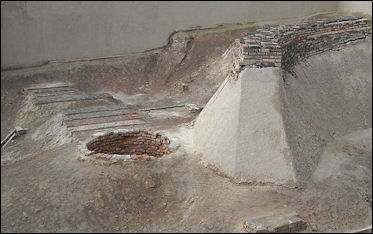
Well and bathing platforms in Harappa Indus cities either had no wall or walls that surround the cities provided a poor defense. Kenoyer told National Geographic that Harappa were comprised of different settlements on mounds. "What's peculiar is that each mound had a wall. They weren't built defense, you could shot an arrow from here across to that one." The walls were about 20 feet high. Kenoyer believes they may have defined areas of different groups or craftsmen.
Dholavira was surrounded by a 5-meter-thick wall. Inside was a citadel surrounded by a wall 18.5 meters thick. There were large homes and a large open space that could have acted as a sports stadium or assembly area or market.
The main gate at Harappa is nine feet across, just wide enough to allow oxcarts to pass comfortable in or out. Kenoyer believes the small gates were used by authorities to keep track of goods flowing and out of the city to levy taxes. "If you were trader," Kenoyer told Discover, "you wanted to bring goods to a city to trade in a safe place, so bandits wouldn't rip you off. To get into the city you paid a tax. If you produced things, you had to pay a tax, you had to pay a tax to take goods out of the city. This is how a city gets revenues."
Indus Sewers, Pools and Water Systems
The people of Mohenja-Daro and Harappan used drainage and sewage systems long before the Romans. In the Indus Valley, archeologist have found private and public baths that back to 3000 B.C. with terra-coat pipes encased in brickwork, with taps to control flow.
The urban water systems of the Indus people was much more advanced than those found in ancient Egypt and Mesopotamia. One of the most remarkable features of Mohenja-Daro is its system of brick-covered drains that were a precursor to a modern sanitation, an idea that didn't really take hold until 4000 years later as a way to stem cholera outbreaks during the Industrial Revolution.
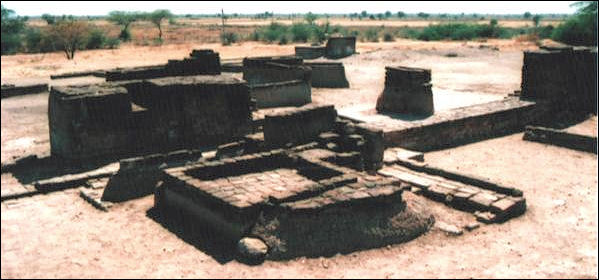
Lothal bath and toilet
Each neighborhood had its own well. Brick culverts carried dirty water out of the city. Some of the drains lead to brick soil-tanks and large jars which acted as septic tanks. To make it easy for ancient sewer workers to climb in the drains and periodically clean them out the system was outfitted with manhole covers. In contrast, city dwellers in Mesopotamia drew water from the river or irrigation canals and had no drains.
A third of the Dholovira's 125 acres was used to collect water through a sophisticated system of chiseled reservoirs, wells, and rainwater tanks. No freshwater streams or rivers flowed into Dholovira. Thus the city relied heavily on collecting water from seasonal monsoon rains.
One archeologist told Time, "In its heyday the whole of Dholavira may have looked like a lake city. Dholavira was built around two streams that were connected to a series of large and small reservoirs that provided a year round supply of water in an arid environment. A large 4.5 meter spillway channeled rain into the citadel. The system was designed to collect water and not waste a drop.
Bricklined baths and wells were so prevalent that some scholars believe water may have had some ritual or religious purpose such as purification. The Great Bath in Mohenjo-Daro is probably the most impressive sight in the ancient city. About the size of a modern swimming pool, it is 39 feet long, 23 feet wide and 8 feet long. It has steps that lead to the bottom and was comprised of brick walls sealed with bitumen. The floor even slants towards a drain. Some scholars believe it may have been the Indus’s equivalent of a temple. Around the pool are square piles of stones that were the walls of ancient dressing rooms. The bath is well made and given a central location which some scholars say suggests made it a center of ritual bathing, similar to what takes place in the Ganges today.
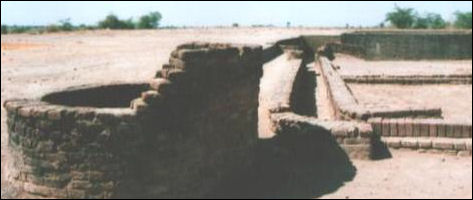
Lothal well and drainage
Indus Food
Richard Meadow of Harvard University told National Geographic, "Skeletons show the population was probably well nourished. Meat seems to have been generally available, to judge by the animal bones we've found." Archeologists have found bones of cattle, sheep, goats, pigs, water buffalo, hens, elephants and camels. “They appear to have been beef eaters. The sacred cow idea had not been developed yet. Dogs appear ro have been kept as pets,” Meadow said.
The Indus people grew barley, two types of wheat, dates, field peas, cotton, sesamum and mustard. Rice husks have been were found at Lothal and Ragpur. A cylindrical strainer found at Harappa was probably used to make beer. DNA studies of human remains show few signs of malnutrition or disease. Even so studies of skeletons unearthed ay one cemetery indicated that the average life span was around 30 years.
Besides cereals and dates (stones of which have been discovered), it appears from halfburnt shells and bones and offerings to the dead that the Indus people used as food pork, beef, mutton, poultry, fish, and the flesh of other water animals. Perhaps milk and vegetables were also included in the dietary. [Source: “History of Ancient India” by Rama Shankar Tripathi, Professor of Ancient Indian History and Culture, Benares Hindu University, 1942]
Indus Items from Daily Life
Among the more interesting objects in the Mohenjo-Daro Archeological Museum are some ancient dice, which have the dots configured exactly as they are today and an old game board that looks like something the Flintstones played on. Marbles, tops, chess-like games, mazes with balls have also been found at Indus sites.
Transportation is believed to be carried out by boats and oxen carts like those pictured on seals. One terra-cotta token shows a boat with a sharply rising prow and stern that is not unlike vessels used on the Indus today.
The earliest lamps were made from sea shells. These were observed in Mesopotamia. Lamps made from man-made materials such as earthenware and alabaster appeared between 3500 and 2500 B.C. in Sumer, Egypt and the Indus Valley. Metal lamps were rare. As technology advanced a groove for the wick was added, the bottom of the lamp was titled to concentrate the oil and the place where the flame burned was moved away from the handle. Mostly animal fats and vegetable and fish oils were burned. In Sumer, seepage from petroleum deposits was used. The wicks were made from twisted natural fibers.
Stone was rare in this region. It had accordingly to be imported from other places for door-sockets, saddle querns and mullers, statuettes, cult objects, etc. The metals known to the Sindhu people were gold, silver, copper, tin, and lead, which were used for a variety of purposes. The discovery of bronze in the earliest layer at Mohenjo-daro proves beyond doubt that it was then in use there. Iron has, however, not been found. [Source: “History of Ancient India” by Rama Shankar Tripathi, Professor of Ancient Indian History and Culture, Benares Hindu University, 1942]
Copper and bronze seem to have superseded stone as material for household implements and utensils. Mostly, however, they were earthenware. Quite a large number of such bowls, dishes, cups, saucers, vases, basins, and stone-jars of different forms have been discovered. Generally the pottery was wheel-made, and was painted and sometimes “glazed.” Likewise copper and bronze had replaced stone for weapons of war or of chase. People were acquainted with maces, axes, daggers, spears, bows, arrows, and slings. Defensive weapons like shields, helmets, and armour were perhaps unknown, nor is there any trace of the sword.
Stones were also used for weights, marbles and dice, which are among the most remarkable relics discovered. The smaller weights, of chert or slate, are cubical, whereas the heavier ones are conical in shape. It is said that they are made with “greater accuracy and consistency than those of Elam and Mesopotamia.”
Generally toys were clay models of birds, animals, men and women, rattles, or representations of carts. These playthings are sometimes useful as depicting the actualities of life.
Occupations in the Indus Valley
The Harappans cultivated wheat, barley, peas and sesamum and were probably the first to grow and make clothes from cotton.Trade seemed to be a major activity at the Indus Valley and the sheer quantity of seals discovered suggest that each merchant or mercantile family owned its own seal. These seals are in various quadrangular shapes and sizes, each with a human or an animal figure carved on it. Discoveries suggest that the Harappan civilisation had extensive trade relations with the neighbouring regions in India and with distant lands in the Persian Gulf and Sumer (Iraq).
It is thought that many city dwellers were traders or artisans. That Harappan society was probably divided according to occupations and this also suggests the existence of an organized government. [Source: Indian government Ministry of External Affairs]
Spinning must have been freely practised in the houses of Mohenjo-daro, as would appear from the large find of spindle-whorls. Those of the rich were made of faience; the poor used the cheaper pottery and shell. Wool was used for warmer textile, and cotton for the lighter one. The latter, found adhering to a silver vase, appears on careful examination by experts to resemble the present-day coarser Indian variety with its “typical convoluted structure.”
Indus Beauty, Jewelry and Clothes
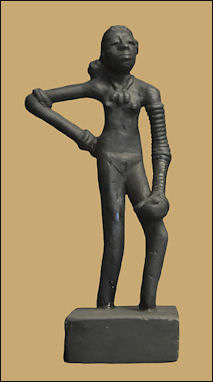
Dancing Girl of Mohenjo-daro Images of people on seals, tokens and tablets indicate that people in different places often wore the same things and had the same hair styles. Men are shown with log hair and are clean shaven or have short beards. Women wear their long in a single braid or a complex hair style piled high with the help of tresses. By same token, people in the same place often had different hairstyles and clothes, which possibly indicates different ethnicity or status.
The Harappans were first people to raise cotton. The earliest known buttons, dated to 2000 B.C., were found in the Indus Valley. The earliest buttons were decorative.
Indus jewelry includes bangles with clover-like designs, gold jewelry, calanite bead necklaces, chokers, belts, and pendants. Some people wore four-inch-tall terra cotta mother goddess. Among the items at the Mohenjo-Daro Museum are gold jewelry, an ancient balance with weights, steatite seals and bead necklaces. A pot filled with jewelry found near Karachi contained silver and gold necklaces, gold bands, beads, rings and a belt made with 36 elongated carnelian beads and bronze beads.
Carnelian beads have also been found at Harappa. Carnelian is a kind of grayish agate that turns to orange-red when baked in a kiln. Drilling holes in it is difficult and time-consuming. The beads were drilled with drills made of copper alloy or stone at a rate estimated at a hundredth of an inch per hour. At that rate drilling a single bead can take several weeks. Bead makers in Khambhat, India still make carnelian beads using the same methods as the Indus people except they use diamond-tipped drills.
A small statue found at Mohenjo-Daro, dubbed the Priest-King, is one of very few Indus-period sculptures depicting a human ever found. This statue of a male figure wearing a long shawl, drawn over the left shoulder and under the right, so as to leave the right arm free. Ornaments, chiefly necklaces, ear-rings, anklets, and girdles of beads, were commonly worn by men and women of all classes. The rich wore one made of gold, silver, ivory, faience and other semi-precious stones like lapis lazuli, jasper, carneliah, agate or onyx; whereas those for the poor were made of copper, bone, shell, and terra-cotta.
The first known dental work was done 9,000 years ago at Mehrgarh, a Neolithic villages in present-day Pakistan. Nine individuals from a sample of 300 buried in graves dating from 5500 to 7000 B.C. Had holes drilled in their molars. David Frayer, a professor of anthropology from the University of Kansas, wrote in Natural History, “This is certainly the first case of drilling a person’s teeth. But even more significant this practice lasted 1,500 years and was a tradition at this site. It wasn’t just a sporadic event.” The oldest recorded dentistry before the discovery was found in Denmark and dated to 3000 B.C.
The discovery was reported in an article in Nature by Roberto Macciarelli of the University of Pontiers in France. “Four teeth show signs of decay associated with the hole, indicating that the intervention in some cases could have been therapeutic or palliative,” he said. No evidence of a filling was found but it is possible that there could have been something that decayed away.
The drilling was done to molars in both the upper and lower jaws to adults. In four of the cases the teeth appeared to have been drilled where the teeth had rotted but in the other cases no tooth rot was present. The holes were between a half millimeter and 3.5 millimeters deep. They appear to not have been done for aesthetic reason because the holes way out of view.
The drilling is believed to have been performed with a flint point spun with a bow. An experimental reconstruction of the probable method involved a small thin piece of flint attached to a bone.
Judging from the angle of the holes they were not self made and because the people who had the dental work were performed on them were not buried in special graves it appears that dentistry was available to anyone and was not just the provenance of the rich. One of the individuals had three molars drilled. Another had one molar drilled twice.
Indus Art and Crafts
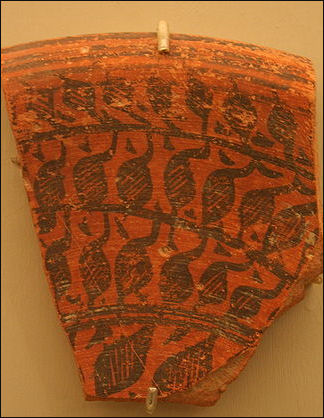
Harappa Fragment of Large Deep Vessel The Indus culture produced sophisticated small crafts such as seals, tokens, figurines and jewelry made of stone, terra cotta, lapis lazuli, bead, copper, bone, ivory, ceramic, gold, silver, shell and faience (ceramics made from powdered quartz fired to produce a ceramic with a glassy finish). Mark Kenoyer of the University of Wisconsin told National Geographic, "If you were a rich merchant, you didn't have to build a huge palace to impress the other elites. You had a beautiful little sculpture that people saw then they came over for dinner."
Jim Shaffer of Case Western Reserve told U.S. News and World Report, "They had tremendous craft technology, if not the best craft technology in the Bronze Age." Some excellent figurines and jewelry have been found in the trash, which indicates that there are better pieces out there or these pieces were toys.”
The Indus people produced a wide variety of terra-cotta and bronze figures and sculptures. Harappan objects, excavated by archeologists include a 4.25-inch-high bronze statuette of a dancing girl, circa 2300 B.C., unearthed from Mohenjo-Daro. At the Mohenjo-Daro Archeological Museum there is a clay figurine of a Mother Goddess, a terra cotta lion head statue and a terra cotta toy cart pulled by terra cotta water buffalos. At Dholovira, archeologists found the remains of a 9-foot-long wooden signboard with ten 15-inch-high symbols made of gypsum. The symbols include a diamond and a spoked wheel. Only a few stone sculptures have been found. Among them are a mongoose and a sitting man with an erect penis (a precursor to Shiva worship?).
Rama Shankar Tripathi wrot; “ The Indus people appear to have made great progress in the ceramic art. They were fond of painted pottery, and some specimens of delicate workmanship and colour have come down to us. They made sculptures of stone and bronze that display great merit and anatomical faithfulness. The figure of a dancer standing on the right leg with the left leg raised in front is beautifully executed, and the pose is so full of movement that there is hardly any parallel to it even among the sculptures of the historic period. The most remarkable are the engravings on the numerous seals and sealings. The treatment of animals, specially the bull, is superb and full of realism. These figures leave no room for doubt that the Indus people, like the ancient Greeks, possessed artistic skill of a high order, and could delineate with vigour and effect.” [Source: “History of Ancient India” by Rama Shankar Tripathi, Professor of Ancient Indian History and Culture, Benares Hindu University, 1942]
Image Sources: Wikimedia Commons, The Louvre, The British Museum
Text Sources: New York Times, Washington Post, Los Angeles Times, Times of London, Lonely Planet Guides, Library of Congress, Ministry of Tourism, Government of India, Compton’s Encyclopedia, The Guardian, National Geographic, Smithsonian magazine, The New Yorker, Time, Newsweek, Reuters, AP, AFP, Wall Street Journal, The Atlantic Monthly, The Economist, Foreign Policy, Wikipedia, BBC, CNN, and various books, websites and other publications.
Last updated September 2020
